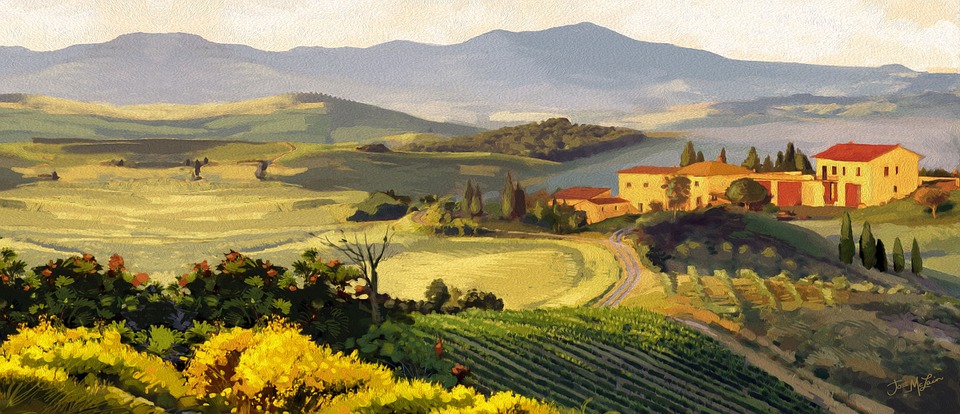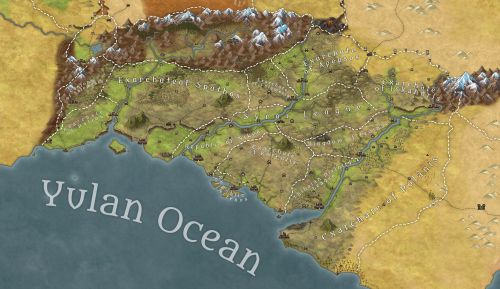Aeilla (/ei̯la/ (Aeillan: /ei̯la/))
Also known as the Galisean cradle of empires, the Aeillan region is a highly developed, highly urbanized region located in south central and southwestern Galisea. The Aeillan region is home to the Aeillan civilization embodied currently in a disunited patchwork of states competing with each other over resources, and power, and in some cases to reunify the whole of the region under a single banner, thus restoring the civilization to its former glory.
Aeilla is extremely densely populated with roughly 32,000,000 people living in the area. This is thanks in large part to the relatively secure position of its boundaries from particularly destructive raiding, nearly ideal conditions for agriculture, plentiful natural resources, infrastructural development, and well organized public institutions and infrastructure well suited to the foundation of large and prosperous societies.
Because of its development and population, Aeilla has a long history of being home to some of the most powerful states to exist in Aeillan history, with the Aeillan Empire in particular being one of, if not the most influential state of its day. In more recent history, Aeilla has become a key part, alongside Qua'adar, and the Dotharan Alliance, of the Talaestrian Sea trading zone, which has become one of the most economically prosperous regions in the whole of Getninia.
Geography
The Aeillan Region is largely enclosed by mountain ranges, with its western border being demarcated by the southern spur of the Odric mountains, its north western border the main body of the Odric Mountains, and its Northeastern, and part of its eastern border being marked by the peaks of the Indric Mountains. Only its southeastern, and north central borders aren't clearly demarcated by mountainous regions, with the north central bordering the Narbari Plateau, and part of the Terruk steppe, and its eastern by the Western deserts of Qua'adar. Both border regions have historically been constested by a series of Aeillan civilizations and a series of other civilizations, and the results of those conflicts having been the formation of what is more or less the modern border between those regions.
Aeilla is be divided into its three component river plains. The largest of these is the Tyros which lies in the east, which runs from the Indri mountains to the Yulan Ocean. The middle river, known as the Ilos runs from the Odric Mountains into the Yulan, which was famous as being the heart of the Aeillan Civilization, and home to most of its most current states. The westernmost, and smallest river, the Spartharii, traditionally marked the western edge of the region before the Aeillan Empire seized part of the western Odric mountains.
Aeilla is a fertile region, as the floodplains of the three rivers deposit vast mineral nutrients into the local soil, and the coastal region in particular receives a lot of rain, making the region extraordinarily well suited to agriculture, particularly in the more developed, civilized regions where water use is well managed. This has resulted in the region becoming one of the most densely settled regions on the continent of Galisea.
Ecosystem
The ecosystem of Aeilla is diverse, in large part due to the relatively extensive territory taken up by the Aeillan Region. Home to thousands of known plants and animals, most of which range over specific biomes of the wider region. Among these include the more prominent creatures such as Wyverns, Griffons and Great Eagles which compete for the niche of top aerial predator, to small plants that are used to create a number of textiles in Aeillan society.
The primary naturally occurring biome of note are the rolling, mostly humid plains which are watered by the three great rivers that cross the Aeillan region, as well as coastal storms that leave the coastal regions even more humid. Interspersed throughout the plains are a number of forests, particularly in the wetter areas of the region. In areas with less water biomes see less biodiversity, sparser forest layouts, and often seasonal patterns of rapid growth, and of drying out, though there are few proper fully arid deserts in Aeilla, all of which are located on the periphery.
For most of recorded history however, much of the Aeillan Region has been dominated by interactions with humans and other sentient beings. In the past century, almost six out of ten kilometers in Aeilla has been taken over by sentient beings, largely for agriculture, but also for other activities such as mining, forestry, and especially for urban settlement. This has definitively impacted the natural processes of the region as water has been siphoned away from certain areas and towards agriculture, and local biomes have been disturbed by human settlements.
Ecosystem Cycles
In Aeilla there are two dominant cycles the coastal and the interior cycle. The coastal cycle, is predominantly wet, within the first three months of a year there is a damp season, with intense fogs and light rains for most of the season, the second three months are comparatively drier, the third becoming wet again, primarily through rain, and the last seeing major intensive storms. The interior cycle is drier, and is less consistent with two loosely defined seasons, a wet season and a dry season with minimal precipitation. The wet season loosely correlates to the stormy season on the coast, though the exact length and intensity of the wet season is highly dependent on the strength of the coastal rains in a particularly, and of relative distance to the coast.
Fauna & Flora
The Aeillan region, despite having largely been taken over by human habitation, and agricultural monoculture, does still possess a fairly wide variety of flora and fauna. Perhaps most unusually, the Aeillan region is known for growing the Illiowiné, or Sun Fruit a small golden fruit widely known for its latent healing properties, as well as possessing a mild halucenogenic effect when made into a beverage. This fruit grows on trees that are found largely on sun facing hillsides in the interior of the region, generally close to major rivers.
Aside from the sun fruit, Aeilla is native to a number of unique strains of grape, and olive plants that produce a uniquely Aeillan series of wines and olive oils, as well as a unique breed of willow tree known as the Weeping Willow. The Wailing Willow's unique branch structure creates a strange acoustic effect akin to crying or wailing, hence its name.
As for animal species, the Aeillan region is home to a number of unique beasts, with Giant Eagles being perhaps the most prominent and widely known creatures indigenous to the region. Similarly the Aurochs, a unique cow specie is also native to Aeilla being cultivated by Aeillan herders to protect the herd, or more rarely as war mounts, and large numbers being sold to the Terruk peoples to the north for unknown purposes. A more dangerous cow variant, the Gorgon is also native to the region, but is deemed a dangerous pest, and has been hunted nearly to extinction.
Dire Wolves and Dire Bears are also thought to have originally have come from Aeilla but were driven to extinction in the area as a result of over a thousand years of intensive hunting. More dangerous creatures, such as Hydras and Manticores are also native to the region, but were never particularly common, and are almost always attacked when encountered. Though not native to Aeilla, Wyverns are nonetheless quite common, and despite being quite dangerous in the wild, are often raised as combat mounts for elite soldiers.
Natural Resources
Aeilla is rich in organic and inorganic adjacent resources thanks in large part to the vast riverine soil deposits, and a decent modicum of rain in most of the region. As a result, Aeilla can count on plentiful wood harvests, and massive agricultural yields, both of which contributue to, and are even necessary for the vast population of the region. Several of the native animal species too can be harvested for useful components, meat, and milk.
Aside from organic resources, Aeilla is also home to vast quantities of mineral wealth, possessing large iron deposits (largely in the more mountainous north), and similarly large deposits of copper and tin which is itself concentrated in the south. Jade is common on the south central coast, and other precious minerals, especially silver can be found in great quantities in the northeastern hills. Limestone, marble, and granite quarries can be found in different areas scattered throughout the whole of the Aeillan Region.
History
The earliest known records of the Aeillan region can be traced back to Yulan-Tai colonization of it. Earliest records indicate that the Yulan-Tai settled the coast regions near the Tyros River from an unknown, and presumably lost island off the coast. These early settlements formed the bedrock of would eventually become the Yulan-Tai Empire. Throughout the Yulani Period, the scope of Yulan-Tai settlement in region would steadily expand as the Empire itself expanded. Towards the later Yulani period, and especially after the ascension of the Yuan-Ti, these settlements would see a great culling, as the ascendant order purged dissidents, and treated the enslaved with much more cruelty. After the War of Frozen Scales, and the collapse of the Yuan-Ti, these settlements too would be be destroyed, with the populations displaced by other populations moving into, or perhaps native to the region.
After the collapse of the Yulan-Tai culture, a number of other cultures would ascend to prominence in the region. The Greck, a Gnomish society, and the Cyrenic dwarves had an early lead, with their relatively safe homes in the mountainous north in establishing post-Yulan societies. Over the centuries however, the Ilosi peoples would become dominant in the central river valley, and gradually unify culturally with the Tyroi, and Spartharoi, becoming the foundations of the Aeillan peoples. In the later days of this period, the Aeillans would displace, subsume, or subjugate other cultures in the region coming to become the dominant force in the region under the banner of the Ilosi Republic, and later Aeillan Empire.
During the Aeillan and Modern periods, the region has come to be defined by the dominance of Aeillan, and especially of Ilosi cultures, with their settlements being by far the dominant in the region. Exceptional foreign settlements have largely occurred at the fringes of the region, with the Grecci in particular having clung to their identity holding onto some territory within some of the Aeillan successor states, particularly in the foothills of the Odric Mountains.
Type
Subcontinent
Location under
Included Locations
Included Organizations
- Aeillan Successor States
- The Aeillan Empire
- The Cantons of Salemesia
- The Exarchate of Apepsos
- The Exarchate of Falemesia
- The Exarchate of Halion
- The Exarchate of Iskandris
- The Exarchate of Korentis
- The Exarchate of Polanis
- The Exarchate of Spathos
- The Ilosi Republic
- The Kingdom of Troinae
- The Republic of Artenos
- The Republic of Nikea
- The Syroi League
- The Thibaian Divinity League
Related Ethnicities
Contested By
Related Tradition (Primary)
Aeilla in Detail:
Aeillan Successor StatesAeillan DnD Story Hooks & Rules



